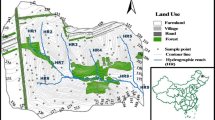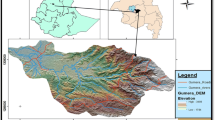Abstract
Characterizing and assessing spatial distribution of soil phosphorus and herbage mass in relation to landscape properties, land use, or landscape positions is important for understanding how pasture sustainability can be managed and improved properly. Our reason for conducting this study was to determine the effects of different slope aspects and slope positions on spatial distribution of soil phosphorus and herbage mass in subtropical pastures. Soil and forage samples were collected from contiguous south-, north-, east-, and west-facing slopes across different landscape positions (top slope, middle slope, and bottom slope) in 100 ha of bahiagrass (Paspalum notatum)-based pastures from 2003 to 2006 in subtropical region of southeastern USA. Averaged across years, soils on the north-facing slope contained the greatest amount of soil phosphorus (12.4 ± 2.7 mg kg−1) when compared with other slope aspects. Slope aspect may be acting as an important topographic factor influencing local site microclimate mainly because it determines the amount of solar radiation received. The greatest herbage mass (averaged across year) of 2,967 ± 980 kg ha−1 and the highest phosphorus accumulation of 7.7 ± 3.0 kg ha−1 for bahiagrass were from the top slope position. There was a significant (P ≤ 0.05) decrease in the average herbage mass and phosphorus accumulation with decreasing slope (top to middle slope). Between the top slope and the bottom slope, herbage mass declined from 2,967 ± 980 to 1,805 ± 370 kg ha−1 while phosphorus accumulation was reduced by approximately 40% (7.7–4.6 kg ha−1). Results of our study may increase awareness on how the arrangement of food, water, and shelter and their interactions with topographic and landscape features can significantly influence the movement of animals and utilization of different pastures’ resources. While our study supports our hypothesis that slope aspect and slope position could be of relative importance in controlling spatial distribution of soil phosphorus and herbage mass, broad knowledge of cattle movement in pasture situations is as critical to understanding their impact on agro-ecosystems.





Similar content being viewed by others
References
Aandahl AR (1948) The characterization of slope positions and their influence on total nitrogen content of a few virgin soils of western Iowa. Soil Sci Soc Am J 13:449–454
Boddey RM, Macedo R, Tarre RM, Ferreira E, de Oliveira EC, de Rezende CP, Cantaritti RB, Pereira JM, Alves BRJ, Urquiaga R (2004) Nitrogen cycling in Brachiara pastures: the key to understanding the process of pasture decline. Agric Ecosyst Environ 103:389–403
Bonan G (1989) A computer model of the solar radiation, soil moisture, and soil thermal regimes in boreal forests. Ecol Modell 45:275–306
Briske DD, Richards JH (1995) Plant responses to defoliation: a physiological, morphological and demographic evaluation. In: Bedunah DJ, Sosebee RE (eds) In: wildland plants: physiological ecology and developmental morphology. Society of Range Management, Denver, pp 635–710
Brubaker SC, Jones AJ, Lewis DT, Frank K (1993) Soil properties associated with landscape positions. Soil Sci Soc Am J 57:235–239
Chambliss CG (1999) Florida Forage Handbook. Univ. Florida Coop. Ext. Serv. SP253
Coble DW, Milner KS, Marshal JD (2001) Above-and below-ground production of trees and other vegetation on contrasting aspects in western Montana. For Ecol Manage 42:231–241
Ganskopp D (1987) Slope use by cattle, feral horses, deer and bighorn sheep. Northwest Sci 61(2):74–81
Ganskopp D (2001) Manipulating cattle distribution with salt and water in large arid-land pastures: a GPS/GIS assessment. Appl Anim Behavior Sci 73:251–262
Gelsomino A, Badalucco L, Landi L, Cacco G (2006) Soil carbon, nitrogen and phosphorus dynamics as affected by solarization alone or combined with organic amendment. Northwest Sci 279:307–325
Gillen RL, Krueger WC, Miller RF (1984) Cattle distribution on mountain rangeland in northeastern Oregon. J Range Manage 37:549–553
Heckranth GP, Brookes C, Poulton PR, Goulding KWT (1995) Phosphorus leaching from soils containing different phosphorus concentrations in the Broadbalk experiment. J Environ Qual 24:904–910
Holechek JL (1988) An approach for setting stocking rate. Rangeland 10:10–14
Holland PG, Steyn DG (1975) Vegetational responses to latitudinal variations in slope angle and aspect. J Biogeogr 2:179–183
Holocheck JL, Pieper RD, Herbel CH (1989) Range management. Principles and Practices. Prenctice Hall, New Jersey. 501 p
Hooda PS, Rendell AR, Edwards AC, Withers PJ, Aitken MN, Truesdale VW (2000) Relating soil phosphorus indices to potential releases to water. J Environ Qual 29:1166–1171
Hyde AG, Law L Jr, Weatherspoon RL, Cheney MD, Eckenrode JJ (1977) Soil survey of Hernando County, FL. USDA-NRCS, Washington, DC and University of Florida, Gainesville, FL. p 152
Martin SC, Ward DE (1973) Salt and meal-salt help distribute cattle use on semi-desert range. J Range Manage 26:94–97
Mathews BW, Tritschler JP, Carpenter JR, Sollenberger LE (1999) Soil macronutrients distribution in rotationally stocked kikuyugrass paddocks with short and long grazing periods. Commun Soil Sci Plant Anal 30:557–571
McBratney AB, Mendonca Santos ML, Minasny B (2003) On digital soil mapping. Geoderma 117:3–52
Mehlich A (1953) Determination of P, Ca, Mg, K, Na, and NH4. North Carolina soil test division. Mimeo, Raleigh
Pastor J, Post WM (1986) Influence of climate, soil moisture and succession on forest carbon nitrogen cycles. Biochemistry 2:3–27
Ryan PJ, McKenzie NJ, O’Connel D, Loughead AN, Lepert PM, Jacquier D, Ashton L (2000) Integrating forest soils information across scales: spatial prediction of soil properties under Australian forests. For Ecol Manage 138:139–157
SAS Institute (2000) SAS/STAT User’s Guide. Release 6.03. SAS Institute, Cary, North Carolina, p 494
Schuman GE, Burwell RE, Piest RF, Spomer RG (1973) Nitrogen losses in surface runoff from agricultural watersheds in Missouri Valley losses. J Environ Qual 2:299–302
Schuster JL (1964) Root development of native plants under three grazing intensities. Ecology 45:63–70
Seastedt TJ, Briggs JM, Gibson DJ (1991) Controls of nitrogen limitation in tallgrass praire. Oecologia 87:72–79
Senft RL, Rittenhouse LR, Woodmansee RG (1983) The use of regression models to predict spatial patterns of cattle behavior. Range Manage J 36(5):553–557
Senft RL, Rittenhouse LR, Woodmansee RG (1985) Factors influencing selection of resting sites by cattle on shortgrass steppe. J Range Manage 38:295–299
Sharpley AN, Withers PJA (1994) The environmentally sound management of agricultural phosphorus. Fert Res 39:133–146
Sharpley AN, Daniel TC, Sims JT, Pote DH (1996) Determining environmentally sound soil phosphorus levels. J Soil Water Conserv 51:160–166
Shigaki F, Sharpley A, Prochnow LI (2006) Animal-based agriculture, phosphorus management and water quality in Brazil: options for the future. Sci Agric 63:194–209
Sigua GC, Coleman SW (2010) Spatial distribution of soil carbon in pastures with cow-calf operations: effects of slope aspect and slope position. J Soils Sediments. doi:10.1007/s11368-009-0110-0
Sigua GC, Williams MJ, Coleman SW (2006) Long-term effects of grazing and haying on soil nutrient dynamics in forage-based beef cattle operations. J Sustainable Agriculture 29(3):115–134
Sigua GC, Hubbard RK, Coleman SW (2009) Quantifying phosphorus levels in soils, plants, surface water, and shallow groundwater associated with bahiagrass-based pastures. Environ Sci Pollut Res. doi:10.1007/s11356-009-0226-1
Smith MS (1988) Modeling: three approaches to predicting how herbivore impact is distributed in rangelands. New Mexico State University, Agricultural Experiment Station, Research Report 628. Las Cruces, NM
Stevens C, Khan VA, Cody RM, Lu JY, Haung Z, Tang AY, Brown JE, Wilson MA (1991) Soil solarization: the effects of organic amendments on microflora of soils rhizosphere of cole crops. Proc. of the 23rd National Agricultural Plastic Congress. Am Soc of Plasticulture 23:281–287
Tamminga S (2006) Environmental impacts of beef cattle. In The John M. Airy Symposium: visions for animal agriculture and environment. Kansas City, MO. p 1–11
Walker PH, Hall GF, Protz R (1968) Relation between landform parameters and soil properties. Soil Sci Soc Am Pro 32:101–104
Wang J, Fu B, Qui Y, Chen L (2001) Soil nutrients in relation to land use and landscape position in the semi-arid small catchment on the loess plateau in China. J Arid Environ 48:357–550
White SL, Sheffield RE, Washburn SP, King LD, Green JT Jr (2001) Spatial and time distribution of dairy cattle excreta in an intensive pasture systems. J Environ Qual 30:2180–2187
Williams MJ, Hammond AC (1999) Rotational vs. continuous intensive stocking management of bahiagrass pastures for cows and calves. Agron J 91:11–16
Yan T, Frost JP, Keady TWJ, Agnew RE, Mayne CS (2007) Prediction of nitrogen excretion and urine of beef cattle offered diets containing grass silage. J Anim Sci 85:1982–1989
Author information
Authors and Affiliations
Corresponding author
Rights and permissions
About this article
Cite this article
Sigua, G.C., Coleman, S.W., Albano, J. et al. Spatial distribution of soil phosphorus and herbage mass in beef cattle pastures: effects of slope aspect and slope position. Nutr Cycl Agroecosyst 89, 59–70 (2011). https://doi.org/10.1007/s10705-010-9376-2
Received:
Accepted:
Published:
Issue Date:
DOI: https://doi.org/10.1007/s10705-010-9376-2




